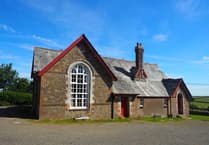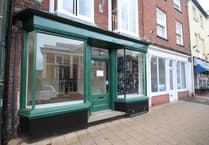“My neighbour is a member of the Crediton Area History and Museum Society,” said Shaun Newman. “He had been to a meeting at Downes and in the corner was a box of what looked like firewood.
“My neighbour said he knew someone who might make use of it. I don’t think anyone really knew what it was. It turned out to be mainly pieces of maple and spruce and some beech.”
One piece bore the name Tertis in pencil, other bits were marked with various dates and names. Shaun became more and more certain the wood had come from the workshop of Richardson who died in 1965.
He said Richardson had been born in Staveley in Derbyshire, the son of an engine driver, he had trained at South Kensington School of Art.
Richardson worked as an industrial wood carver in Leeds as a pattern maker, carving wood in relief to be pressed into a bed of alluvial sand from which a cast iron plate would be made. This could be, for example, used for a crest or for a badge for an engine body. Pattern making was always regarded as a very highly skilled trade.
It was his wood carving ability that took Richardson to ecclesiastical work and to the Crediton firm of Dart and Francis at the beginning of World War One.
A violinist since his schooldays, from 1912 Richardson had made violins as a hobby.
His home on Hunivers Place at Winswood, Crediton has been demolished, but some local people still remember seeing his instruments drying on the washing line.
He later began making violas after meeting the British performer, Lionel Tertis, and was a key part of the development and refinement of the Tertis model viola. Richardson received an MBE for services to music in 1961.
There is a blue plaque commemorating his achievements on the wall of Crediton Library, overlooking the bowling green where he was a regular player. There is also an ageing park bench on the edge of the green which bears a brass plaque in his memory.
Shaun added that Richardson was a prolific instrument maker, making more than 500 violins, violas and cellos at Crediton. One of his cellos sold at auction for more than £9,000 some 20 years ago.
He said that among the pieces of wood he was given, two wedges of spruce were marked in pencil with the year 1922, making them exactly 100 years-old. They were just wide enough to make the front of the guitar, provided the instrument would be rather smaller than usual.
Shaun again: “Apparently there was a wooden viola case on top of this wood. It had a note in it saying that the case was made by Arthur Richardson, never fully restored, but I have no idea how it got from his place to Downes.
“It was extraordinary to see the name ‘Tertis’ on one of the bits of wood, and written in Richardson’s own hand,” he said. “The pieces of spruce were, of course, now very well-seasoned. I had to use my own maple for the back and sides of the guitar, and mahogany for the neck, but Richardson’s spruce became the front.
“This is the most important part of a stringed instrument because this is where most of the sound comes from and his wood has given this instrument a wonderfully mellow sound.”
Shaun went on to say: “I have made this guitar in the ‘baroque’ style. It is interesting that the word ‘baroque’ derives from the Portuguese for a misshapen pearl. I hope this one does not appear misshapen!”




